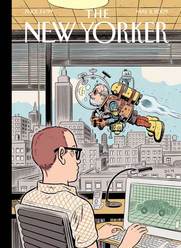Emdashes—Modern Times Between the Lines
The Basics:
About Emdashes | Email us
Ask the Librarians
Best of Emdashes: Hit Parade
A Web Comic: The Wavy Rule
Features & Columns:
Headline Shooter
On the Spot
Looked Into
Sempé Fi: Cover Art
Sempé Fi (On Covers): Jet-Packing Through the Gates of Horn and Ivory
Filed under: Sempé Fi Tagged: art, automobiles, covers, Daniel Clowes, pigeons, Pollux

Pollux writes:
He wasn’t easily distracted. Occasionally a pigeon would flutter by; he wouldn’t look up. Sometimes his iPod malfunctioned and played the same song twice; he wouldn’t notice. You could hear Keane’s “She Has No Time” a million times anyway and never get sick of it.
But today was different. All was quiet and normal, and then suddenly he heard something that sounded like a cross between a backfiring ‘58 Biscayne and a beer siphoning a homebrew. A sound like PutTUTtatatataGLOOglooglooputputTUT.
An old man was flying.
This old man didn’t mean to fly by the office of one of the city’s up-and-coming car designers (let’s call him Stephen), who is considered a true innovator by his peers and by Stephen’s new wife (he got married last month).
It was a good test run for the old man, and he didn’t end up falling out of the sky like a liver-spotted Icarus and dashing his brains on the corner of Broadway and Eighth.
The old man (let’s call him Buster) never went to college. This is the story of his life: he lied about his age in order to join the Navy, saw the world (mostly the Pacific) and saw some action on a swift-boat penetrating the Giang Thanh-Vinh Te canal system in North ‘Nam. He married his high school sweetheart and then lost her to cancer. He’s worked as a machinist, junkyard watchman, ticket collector on the railway, and sign-painter. He’s worked in a dead letter office, plastic packaging plant, textiles factory, and pet store. Buster has suffered from chemical burns on both hands, and currently suffers from high blood pressure, osteoporosis, and urinary incontinence. He remembers the friends he lost on the Giang Thanh-Vinh Te canal system. The only time he’s happy is when he’s tinkering around in his garage. Buster always wanted to fly, so he decided to build a jetpack.
If he had any friends, they’d laugh at him.
On the other hand, Stephen, our up-and-coming car designer, has plenty of friends. They envy his life and drink his expensive wine over a spirited game of Cranium. Stephen was a precocious child, and designed cool-looking soap-box racers when all of the other kids were duck-hunting with their Nintendoes. His excellent portfolio got him accepted to the Art Center College of Design in Pasadena, where he learned 3-D modeling and where to get the best marijuana (Venice Beach) and the best Retro Nerd Square Glasses (again, Venice Beach). He won the prestigious EcoAuto Concept Award in 1998 and shook hands with the then-CEO of General Motors, John F. Smith, Jr.
Adhering to the “theory and practice” approach to learning, Stephen met with practicing designers, engineers, and anyone remotely connected with the auto industry. He did a summer internship at the UmeÃ¥ Institute of Design, in Sweden, and after his time at Pasadena, did a two-year automotive stylistics program at the Istituto di Scienze dell’Automobile, in Modena, Italy. Modena was the source of much of the wall decorations that brighten up Stephen’s spacious New York apartment. It was a cinch for him to find a job in a car design firm in the Big Apple in a time when the economy had not yet sunk like a power boat with badly made deck-to-hull joints. Stephen had done everything right.
Such is the dichotomy presented on Dan Clowes’ cover for the May 11, 2009 issue of The New Yorker, called “Leading the Way.” The May 11, 2009 issue is the Innovators Issue, and Clowes is an innovator in his own right, having created works that transcend the appellation of “comics” and are instead works of literature that happen to be fully illustrated, the best known perhaps being Ghost World.
Clowes’ artistic style is not necessarily photo-realistic but always appears as if his subjects have been drawn from life, penciled on a subway and then inked carefully at home. You feel as if Clowes has seen a young man like Stephen somewhere, as well as an old man like Buster, perhaps not necessarily flying on a jet-pack. The New Yorker cover coincides with the announcement of a new book by Clowes, as yet unnamed, that concerns, as stated in this interview, “a guy whose father dies, and he’s completely alone, so he tries to reconstruct what he’s lost, to approximate a nuclear family by joining people together.”
Clowes’ jet-packing senior also seems like someone who is completely alone, who has built his dream out of spare mechanical parts and perhaps an old fishbowl. Clowes has drawn outsider innovators before. His May 12, 2008 cover depicted a two-page act of creation. An inventor builds himself a powerful robot just so that he sit down to a good game of cards. In the same way, Clowes’ jet-packing senior just wants to fly. He’s not trying to revolutionize the airline industry.
And then there’s the young, hip car designer: all this education and experience under his belt, and Stephen has ended up designing a fairly conventional-looking car.
Who remains deskbound, boring, and conventional? Stephen.
But who flies as free as a bird? Buster.
Sometimes the old, and the old-school, lead the way.




